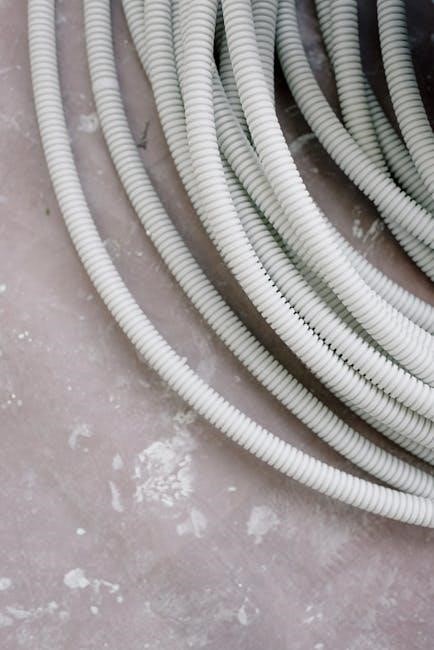The AdBlue system in Mercedes vehicles is a critical emissions control component, but it can develop faults, leading to warning lights and reduced performance. Issues often stem from faulty sensors, contaminated fluid, wiring problems, or software glitches, requiring prompt attention to maintain efficiency and compliance with emissions standards.
Common Causes of AdBlue System Faults
AdBlue system faults in Mercedes vehicles often arise from faulty sensors, contaminated or low-quality AdBlue fluid, issues with the AdBlue tank, wiring faults, or software glitches.
2.1. Faulty Sensors
Faulty sensors are a common cause of AdBlue system faults in Mercedes vehicles. These sensors monitor critical parameters like fluid levels, temperature, and NOx emissions. If they malfunction, the system may incorrectly detect issues, triggering warning lights or error codes. For instance, a faulty AdBlue tank sensor can falsely indicate low fluid levels or contamination, while a defective NOx sensor might report emission anomalies; Such failures often stem from corrosion, wiring issues, or software glitches.
Symptoms of faulty sensors include persistent warning messages, reduced engine performance, or even a complete system shutdown; Diagnosing sensor faults typically involves using an OBD2 scanner to identify error codes. In some cases, sensors may need to be cleaned or replaced to restore proper system function. Addressing sensor issues promptly is crucial to prevent further damage to the AdBlue system or related components.
2.2. Contaminated or Low-Quality AdBlue Fluid
Contaminated or low-quality AdBlue fluid is a frequent cause of system faults in Mercedes vehicles. The fluid, a urea-based solution, must meet strict specifications to function properly. If it becomes contaminated with water, dirt, or incorrect substances, it can cause clogs in injectors and lines, leading to system malfunctions. Additionally, using low-quality or expired AdBlue fluid can degrade the solution’s effectiveness, triggering error codes and warning lights.
Short journeys, where the fluid is not fully utilized, can also lead to crystallization, further exacerbating issues. Diagnosing fluid-related problems involves checking its quality and levels. In such cases, flushing the system and refilling with high-quality AdBlue is often necessary. Always use manufacturer-approved fluid to ensure compatibility and prevent damage to the emissions control system. Regular checks and proper storage can help avoid contamination and maintain system efficiency.
Issues with the AdBlue tank are another common cause of system faults in Mercedes vehicles. The tank can develop leaks, cracks, or internal damage, leading to fluid loss and system malfunctions. Corrosion or clogging of the tank’s sensors and injectors can also occur, disrupting communication between components. Faulty tank sensors may incorrectly report fluid levels or temperature, triggering false warnings or error codes. Additionally, improper installation or maintenance of the tank can exacerbate these issues. Regular inspections and prompt repairs are essential to prevent further damage. Ensuring the tank is free from contaminants and functioning correctly is crucial for the overall efficiency of the AdBlue system. Addressing tank-related problems early can help avoid costly repairs and maintain emissions compliance. Always refer to the owner’s manual for specific guidelines on tank maintenance and troubleshooting. Proper care can extend the lifespan of the system and ensure optimal performance. Wiring faults are a common issue in Mercedes AdBlue systems, often leading to system malfunctions. Corrosion, wear, or damage to the wiring loom can disrupt communication between sensors and the control module. Faulty connections or short circuits may cause incorrect readings or error codes. For instance, a corroded power wire can prevent proper sensor function, triggering warnings. Regular inspections of the wiring harness are essential, especially in areas prone to moisture or heat. Addressing wiring issues promptly is critical to avoid further damage. In some cases, replacing the affected wires or connectors is necessary to restore system functionality. Proper diagnostics using tools like an OBD2 scanner can help identify wiring-related problems. Ensuring the electrical system is in good condition is vital for the AdBlue system to operate reliably and maintain emissions compliance. Always consult the owner’s manual for guidance on wiring inspections and repairs. Timely fixes prevent costly overhauls. Software glitches in the AdBlue system of Mercedes vehicles can cause unexpected malfunctions. These issues often arise from outdated or corrupted control module software, which may misinterpret sensor data or fail to communicate properly. Symptoms include erroneous warning lights, incorrect fluid level readings, or system shutdowns. In some cases, a software update or reflash of the control unit can resolve the problem. It’s crucial to use genuine Mercedes software tools to avoid further complications. Regular system checks and updates, as outlined in the owner’s manual, help prevent glitches. If issues persist, consulting a certified technician is recommended to ensure the system operates correctly and maintains emissions efficiency. Addressing software-related faults promptly ensures optimal performance and avoids potential damage to other system components. Always follow manufacturer guidelines for software updates to maintain system integrity. Timely intervention prevents prolonged downtime and costly repairs. Diagnosing AdBlue system faults involves checking fluid levels, inspecting components, and using an OBD2 scanner to identify specific issues. This methodical approach ensures accurate troubleshooting and effective repairs, as outlined in the owner’s manual. Checking the AdBlue fluid level and quality is a crucial first step in diagnosing system faults. Low levels or contamination can trigger warning lights. Use the owner’s manual to locate the tank and ensure the fluid meets manufacturer specifications. Inspect for crystallization or discoloration, which may indicate poor-quality fluid. If levels are low, refill with genuine AdBlue solution. Avoid using low-quality alternatives, as they can cause further issues. If the fluid appears contaminated, flushing the system may be necessary. Always follow the manufacturer’s guidelines to prevent damage to the system. This step helps identify common issues before moving on to more complex diagnostics. Inspecting key components of the AdBlue system is essential for identifying faults. Start by examining the AdBlue tank for leaks or damage. Check the sensors, including the tank level sensor and NOx sensor, for proper function. Ensure all wiring connections are secure and free from corrosion. Inspect the AdBlue injectors and lines for blockages or crystallization, which can occur due to poor fluid quality or short journeys. Additionally, verify the condition of the in-tank heater and pump. If any component shows signs of wear or damage, it may need replacement. Always consult the owner’s manual for specific locations and procedures. This step-by-step inspection helps pinpoint issues quickly, preventing further system damage. Regular checks can also help maintain system efficiency and avoid costly repairs down the line. Using an OBD2 scanner is a crucial step in diagnosing AdBlue system faults in Mercedes vehicles. Connect the scanner to the vehicle’s OBD2 port, typically located under the dashboard. Once connected, the scanner will retrieve fault codes related to the AdBlue system, such as P13DF09, which indicates a system malfunction. These codes provide valuable insights into the root cause, whether it’s a faulty sensor, contaminated fluid, or wiring issues. After identifying the issue, the scanner can also be used to reset the system or clear codes after repairs. Regular use of an OBD2 scanner helps in early detection of problems, preventing further damage. Always refer to the owner’s manual for specific instructions on using the scanner with your Mercedes model. This tool is essential for both DIY enthusiasts and professionals to ensure accurate diagnostics and efficient troubleshooting. Wiring faults are a common cause of AdBlue system malfunctions in Mercedes vehicles. To identify such issues, inspect the wiring harness connected to the AdBlue system, including sensors, pumps, and control modules. Look for signs of wear, corrosion, or damage, such as frayed wires or loose connections. Use a multimeter to check for conductivity and ensure there are no open circuits or short circuits. Pay particular attention to areas exposed to moisture or heat, as these are prone to damage. If wiring faults are detected, repair or replace the affected components promptly. In severe cases, such as corroded power wires, professional assistance may be required to prevent further system damage. Always consult the owner’s manual for specific guidelines on inspecting and repairing wiring related to the AdBlue system in your Mercedes model. Flushing the AdBlue system, replacing faulty components, and addressing NOx sensor issues are effective solutions to resolve system faults, ensuring proper function and emissions compliance in Mercedes vehicles. Flushing the AdBlue system involves draining the old fluid and using a specialized solution to clean the lines and components. This process helps remove contaminants and crystallized urea, ensuring optimal flow and system performance. After flushing, the system is refilled with high-quality AdBlue fluid that meets manufacturer specifications. Regular flushing can prevent clogs and sensor malfunctions, while addressing issues like warning lights or reduced engine efficiency. It’s a crucial step in maintaining the integrity of the emissions control system. Always use approved materials and follow proper procedures to avoid further damage or contamination. This method is effective for resolving faults related to degraded or contaminated AdBlue fluid in Mercedes vehicles. Ensure the system is reset after flushing to clear any error codes. Flushing should be performed by a qualified technician or DIYers with the right tools and knowledge. Replacing faulty components is essential for resolving persistent AdBlue system issues in Mercedes vehicles. Commonly, sensors, pumps, or injectors may fail, requiring replacement with genuine or compatible parts. The process begins with identifying the defective component using diagnostic tools like an OBD2 scanner. Once identified, the faulty part is carefully removed and replaced, ensuring all connections are secure and clean. Proper installation is crucial to prevent future malfunctions. In some cases, such as a malfunctioning NOx sensor or a damaged AdBlue tank, specialized tools and expertise may be necessary. After replacement, the system must be reset and tested to ensure proper function. Regular maintenance can help prevent such issues, but when they occur, timely replacement is vital to restore system efficiency and avoid further complications. Always refer to the owner’s manual or manufacturer guidelines for specific instructions. NOx sensor issues are a common cause of AdBlue system faults in Mercedes vehicles. These sensors monitor nitrogen oxide emissions, and their failure can trigger warning lights and reduce engine performance. Symptoms may include a “Check Engine” light, decreased fuel efficiency, or a persistent AdBlue warning. Diagnosing NOx sensor problems typically involves using an OBD2 scanner to retrieve fault codes, such as P13DF09, which indicates a sensor malfunction. In some cases, cleaning the sensor may resolve the issue, but often, replacement is necessary. Ensure the replacement sensor meets OEM specifications to maintain system accuracy. After installation, reset the AdBlue system and test drive the vehicle to confirm proper function. Addressing NOx sensor issues promptly prevents further complications and ensures compliance with emissions standards. Always consult the owner’s manual or seek professional assistance if unsure. Regularly check AdBlue fluid levels and quality, avoid short journeys to prevent crystallization, and ensure only high-quality AdBlue is used to maintain system efficiency and avoid faults. Regular fluid checks are essential to ensure the AdBlue system operates effectively. Check the AdBlue fluid level using the dashboard indicator or the owner’s manual guidelines. Always use high-quality AdBlue fluid that meets ISO 22241 standards to prevent contamination. Inspect the fluid for clarity and color, ensuring it remains a clear, water-like solution without any discoloration or particles. If the level is low, refill promptly to avoid triggering system warnings. Additionally, after refilling, reset the system if necessary, as outlined in the manual. Regular fluid maintenance helps prevent clogs, sensor malfunctions, and reduces the risk of costly repairs. Consistency in these checks ensures optimal performance and compliance with emissions standards, safeguarding your vehicle’s efficiency and reliability. Avoiding short journeys is crucial for maintaining the health of the AdBlue system in Mercedes vehicles. Frequent short trips can prevent the system from reaching optimal operating temperatures, leading to incomplete urea injection and potential crystallization in the injectors or sensors. This can cause clogs, faulty readings, and system malfunctions, triggering warning lights or error codes. Prolonged short journey patterns may also degrade the effectiveness of the NOx reduction process, increasing emissions and risking further complications. To mitigate this, drivers should combine errands or opt for longer drives when possible. If short trips are unavoidable, regular system checks and fluid flushes are recommended to prevent buildup and ensure proper function. By minimizing short journeys, owners can reduce the likelihood of AdBlue-related faults and maintain their vehicle’s performance and efficiency. To reset the AdBlue system in your Mercedes, turn the ignition on without starting the engine. Press and hold the gas pedal fully for 20 seconds, then release, turn off the ignition, and restart the engine. This process often clears minor system faults and warning lights. Resetting the AdBlue system in a Mercedes C-Class can often resolve minor faults. Start by turning the ignition to the “on” position without starting the engine. Next, fully press and hold the gas pedal for approximately 20 seconds. Release the pedal, then turn the ignition off and wait a few seconds. Restart the engine to complete the reset process. If the AdBlue warning light persists, ensure the fluid level is adequate and the quality is correct. If issues remain, use an OBD2 scanner to check for specific fault codes. In some cases, a professional diagnostic tool or dealership intervention may be required to clear persistent system errors. Regular resets can help maintain system functionality and prevent unnecessary warnings. A Mercedes-Benz A-Class (W177) with a persistent AdBlue warning was diagnosed and resolved by inspecting key components like sensors and wiring, leading to the replacement of faulty parts. A Mercedes-Benz A-Class (W177) equipped with the OM654 diesel engine presented with a persistent AdBlue warning message. The vehicle was brought to a workshop after the owner noticed reduced performance and an illuminated dashboard warning light. Initial diagnostics revealed issues with the NOx sensors and wiring faults, which were causing the AdBlue system to malfunction. Technicians performed a thorough inspection, including checking the AdBlue tank sensor and fluid quality. The root cause was identified as a combination of faulty sensors and wiring corrosion. The solution involved replacing the NOx sensors, repairing the wiring, and flushing the AdBlue system. After these repairs, the warning light was reset, and the vehicle returned to normal operation. This case highlights the importance of addressing AdBlue system faults promptly to avoid further damage and maintain emissions compliance.2.3. Issues with the AdBlue Tank
2.4. Wiring Faults
2.5. Software Glitches

Diagnostic Procedures
3.1; Checking AdBlue Fluid Level and Quality
3.2. Inspecting Key Components
3.3. Using an OBD2 Scanner
3.4. Checking for Wiring Issues
Repair and Replacement Solutions
4.1. Flushing the AdBlue System
4.2. Replacing Faulty Components
4.3. Addressing NOx Sensor Issues

Preventive Maintenance Tips
5.1. Regular Fluid Checks
5.2. Avoiding Short Journeys

Resetting the AdBlue System
6.1. Steps for Mercedes C-Class Reset

Case Studies and Real-World Examples
7.1. Mercedes-Benz A-Class (W177) Case Study
